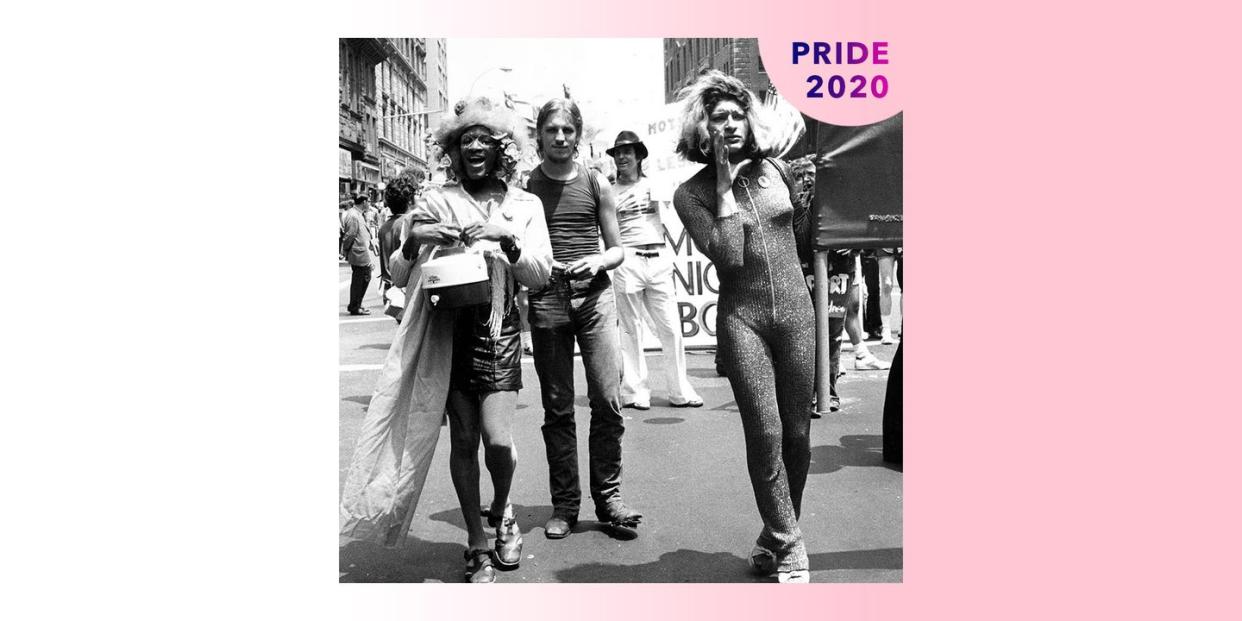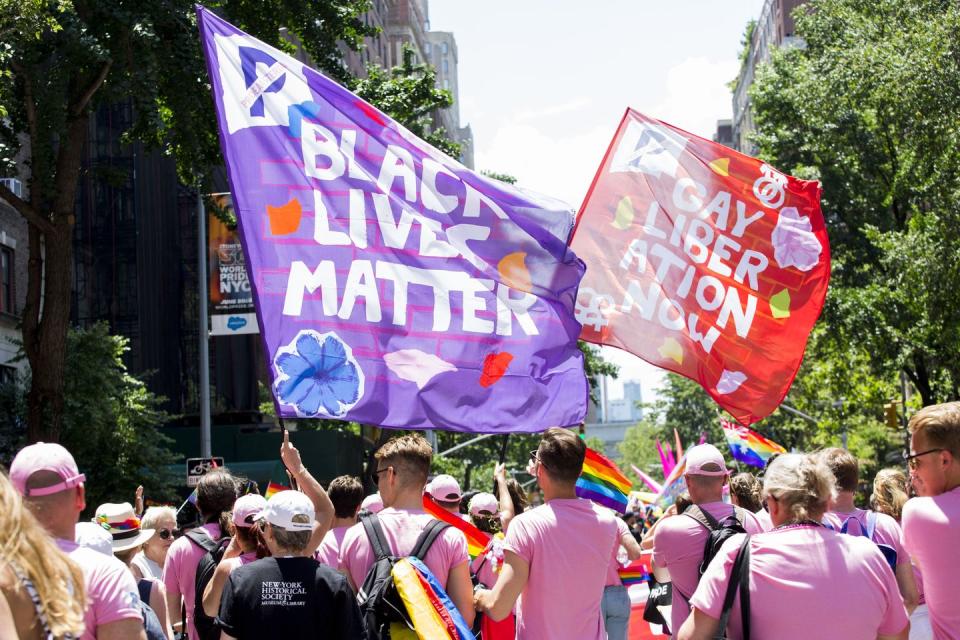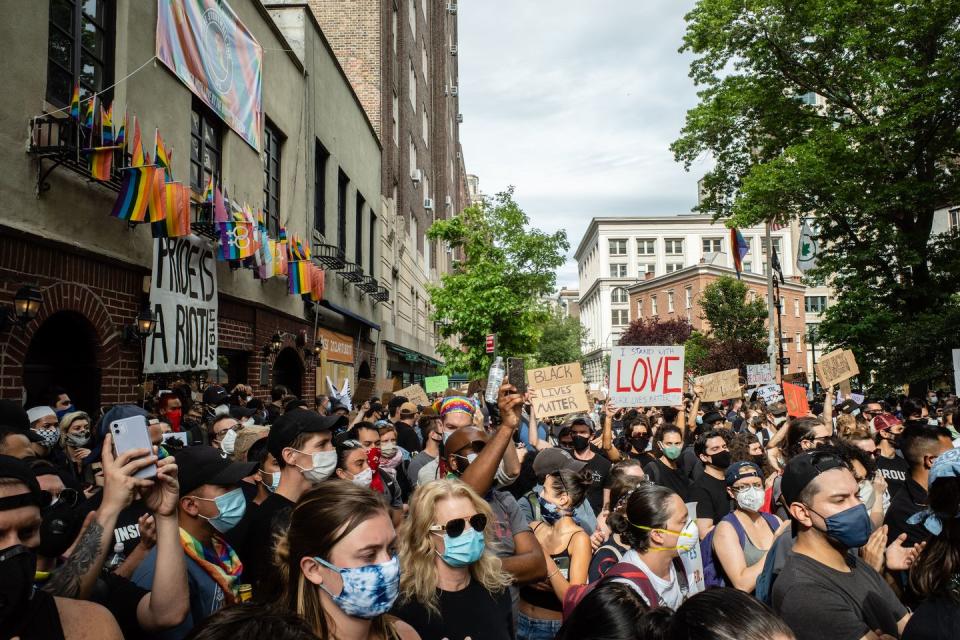Pride Has Always Been a Protest Against An Unjust System

Pride has never looked like this before. Parades are canceled. Gatherings are a public health concern. But that hardly means that Pride is canceled; scores of people have taken to the street in protest for Black Lives Matter. For those who can't, celebrating Pride in quarantine is a protest itself. This month, Esquire is examining what Pride means now, beyond the parade and for the next 50 years—whether it's advocating for justice over Zoom, discovering the intersectionality too often missing from Pride, or simply existing as a trans father. The protest continues.
This Pride month is different. It’s different because the spread of COVID-19 has driven celebrations online, cancelling parades, festivals, and other in-person activities. But it’s also different because as the month unfolds, so too do ongoing demonstrations against police brutality, systemic anti-blackness and institutionalized white supremacy. On the surface, it might seem like these two movements are diametrically opposed—one a community celebration, the other an enraged protest of an unjust system.
In reality however, they couldn’t be more alike. That’s because Pride was—and still is, despite it’s corporatization and sanitization—a protest. Inspired by the Civil Rights Movement, our trans and queer ancestors fought tooth and nail, quite literally, to have their humanity recognized, just as black people who lead the current social unrest demand the right to live without fear of death because of the color of our skin. And considering it was queer and trans people of color whose audacity ignited the LGBTQ+ rights movement, it’s time the benefactors of their labor—white LGBTQ+ people and their allies—join the Black Lives Matter movement.
One of the first demonstrations in U.S. history in support of LGBTQ+ rights took place in 1966 at Compton's Cafeteria in San Francisco’s Tenderloin district. One August night, management of the 24-hour diner called the police on the trans women and drag queens who congregated there. Officers arrived, and when a cop tried to arrest one of the trans women, she threw her hot coffee in his face. Within minutes, dozens of trans people and drag queens spilled onto the street in opposition. They broke the restaurant's glass windows and set a nearby newspaper stand on fire. Though many of them were arrested, more LGBTQ+ people returned to Compton’s Cafeteria the following night to continue the protest. That unrest inspires much of the queer and trans-led organizing in the city to this day, which is now home to the world’s first Transgender Cultural District.

A year after the demonstration at Compton’s, another protest took place, this time in response to a raid on Black Cat Tavern in Los Angeles. While ringing in the New Year, plainclothes LAPD officers blitzed the queer establishment and beat its patrons. Fourteen people were arrested that night for “lewd” conduct. Two months later, on February 11, 1967, hundreds gathered outside the bar in a peaceful protest of “police lawlessness.” Surely they hoped their show of discontent would lead to change, but the continued lawlessness of police forces nationwide, including the LAPD, is the very reason so many have taken to the streets today in every single state. A persistent lack of accountability for those who are sworn to protect us snuffed out the lives of George Floyd, Breonna Taylor, Tony McDade and countless others.
Two years after the Black Cat protest, the now-iconic Stonewall uprising took place in New York City. Like so many others, the Stonewall riots were a response to an unjust system built to suppress the LGBTQ+ community. Spurred by a scuffle involving Stormé DeLarverie, a biracial, butch-presenting lesbian, the community erupted in anger—fighting against the discrimination they’d once tolerated as a means of survival.

The riots lasted several nights, through July 3, with black and brown queer and trans folks, like Marsha P. Johnson and Sylvia Rivera, leading a revolution. It was all in an effort to let law enforcement, and by association the political establishment, know that the community was no longer going to passively accept bigotry and brutality. On the one-year anniversary of the Stonewall event, which is credited with launching the modern LGBTQ+ rights movement, the first Pride marches were held in New York, Los Angeles, and Chicago all under the guise of asserting the humanity of LGBTQ+ people.
These calls of yesteryear, for respect and the dismantling of systems that continue to oppress us, remind me of the chants of the thousands of demonstrators in the streets today. And they are the connection between the Black Lives Matter movement and the LGBTQ+ rights movement—if my body as someone black, queer, and gender nonconforming wasn’t already enough. Protest is the history of LGBTQ+ people, of a community that had to demand recognition of our humanity through the very types of violence we faced.

There seems, however, to be a disconnect for many. Perhaps it’s because some mainstream conceptions of Pride—the parties, the half-naked, glitter-clad muscled bodies, the inclusion of police forces in demonstrations—are no longer a reflection of its foundation. After all, it is our right to celebrate the gains the community’s made, even as black and brown LGBTQ+ people continue to bear the brunt of societal ills. But the celebration doesn't, and shouldn’t, erase the roots of revolution that begat it.
It becomes imperative then that white LGBTQ+ people and their allies become vocal supporters of the Black Lives Matter movement. Now isn’t the time to sit on high horses, looking down on protestors and mischaracterizing their rage. It’s time to get out in the streets and support the unfolding revolution. Because if it wasn’t for a similar rage, the rage that bubbles over after prolonged oppression, the broader LGBTQ+ community wouldn’t enjoy the freedoms they currently do—not to mention how the queer rights movement has modeled itself after, in large part, the Civil Rights Movement.
Pride was a protest. It was a riot chock full of looting and fires and justified violence. It is still very much an uprising. And though this Pride month may be different than those that have come before in recent memory, it is yet the same as it was some 50 years ago.
To quote Martin Luther King Jr, “a riot is the language of the unheard,” whether it be in protest of homophobia and transphobia, or anti-black police brutality and white supremacy. Hopefully, the world is listening.
You Might Also Like


